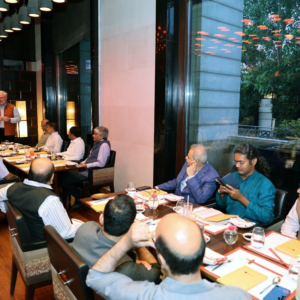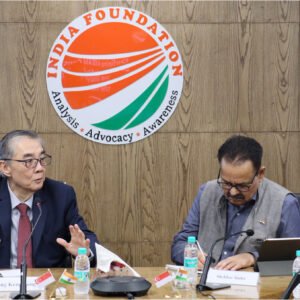India’s rise to a USD 10 trillion economy within the next 10 to 15 years has been often spoken off with a great deal of optimism by economists in India and abroad. Now, a recent report by a London-based consultancy, Centre for Economics and Business Research (CEBR), has also reiterated the same. In its report published in December 2022, CEBR states that at a time when the world is moving into recession, India’s growth rate over the next decade will average 6.5 percent, propelling India into the USD 10 trillion bracket by 2035 and to third position in global rankings. But there was a cautionary note too. Political factors, the report stated, could hold India back.[1]
It is however, not just political factors which we need to be concerned about. There are social and economic factors too, which could spoil the India growth story. India’s rise as an economic power is not something which India’s adversaries are taking kindly to. On the contrary, they are doing all in their power to stymie India’s growth story. Some western countries too, with whom India shares good relations, are also averse to the idea of an economically strong India which is also moving towards self-sufficiency in advanced technology. They see in a growing India, a potential threat to their economic interests. These countries too, would like to see an India which is perpetually dependent on them—an India which perforce plays second fiddle to Western interests.
That of course, is not how the story will play out. Leaving aside a black swan event, India’s growth story can, at the worst be delayed, not denied. But both India’s adversaries as also some who are India’s friends, have been exploiting internal fault lines within India, to muddy the waters of India’s rise. Opposition to India’s rise has come in the political, social and economic domain and while India has faced up to these challenges stoically over the last few years, the coming years will, in all likelihood, see a renewed effort on the part of both internal and external agencies to create trouble and fissures within Indian society.
There was consternation in many capitals across the world when the NDA government was sworn in, in 2014, as they felt that the leverage they enjoyed with earlier governments would not be available. On that score they were right. That led to a series of events, orchestrated from within the country, but with huge funds supplied from abroad, to showcase India as an intolerant country. That is why we saw protests erupt in the country, on various issues, but timed for effect, to peak in January, when the eyes of the world would be on India’s Republic Day celebrations. These protests ranged in the social sphere from allegations of human rights abuses to intolerance towards religious minorities. In the economic domain, we witnessed protests against Sterlite Copper, the Kundankulam nuclear power plant, the Narmada Dam and many others. In the political domain, there were protests against the farm laws and the Uniform Civil Code, which were used to disrupt normal life.
It is likely that some of the protesting groups had genuine concerns about certain government policies. In a vibrant democracy such as exists in India, expressing an alternate point of view is a part of the democratic process. But the methods used to express discontent were uncalled for. It became apparent that the protests were designed to create anarchy and fissures in society through disruption and violence. Many areas were blockaded for months on end in an attempt to shut down parts of the country, but it redounds to the wisdom and maturity of the Indian masses that they did not fall prey to such disruptive tactics and the nation emerged stronger and more united, with a focus on growth. Indeed, since 2014, we have had major reforms in the Indian polity, foremost among them being the Goods and Services Tax (GST) and the revocation of the special status given to Jammu and Kashmir through Article 370.
GST unified the country economically, by making provisions for a single tax on the supply of goods and services, right from the manufacturer to the consumer. With its implementation, a variety of earlier indirect taxes, including the value-added tax, service tax, purchase tax, excise duty, and others were done away with, making it easier for business entities. The apprehensions expressed by some who opposed the GST have been blown away by the successful implementation of this transformative economic reform. Throughout the current financial year, GST collections have been in excess of Rs 1.4 lakh crore, despite the fact that the Indian economy as well as the world economy was badly impacted by the Covid pandemic in 2020 and 2021. The revocation of the Special Status given to the state of Jammu and Kashmir under Article 370 and the bifurcation of the state into two union territories, Ladakh and Jammu and Kashmir, was perhaps the most important legislation passed since independence. The move was bitterly opposed by certain political groups, but the events on the ground since then have thrown up for the first time, the possibility of peace in the Union Territory of Jammu and Kashmir after over three decades of violence and bloodshed. These and many other reforms such as the abolition of instant triple talaq were vigorously opposed by certain interest groups, but were the need of the hour.
But many more important legislations are required, to truly reflect a vibrant, secular and democratic India. As we enter 2023, we need to anticipate the opposition that the reforms process will generate in certain quarters and through positive narrative building, prevent disruptive elements within society to hold the country to ransom. Reforms are required on many sensitive issues such as the Waqf Act, which was first passed by Parliament in 1954 and which was subsequently repealed, only to be replaced by a new Waqf Act in 1995 which gave it extraordinary powers, not in consonance with the Indian Constitution. Other issues pertain to the control of many Hindu temples by the government, which is against the very concept of a secular state. Protecting the rights of Muslim women needs reform on issues such as polygamy, wearing of hijab, the practise of nikah halala as also of equal rights in inheritance. This will have to be undertaken through the legislative process as it will not be forthcoming from within Muslim society and will find resonance when the issue of adopting a Uniform Civil Code comes up.
With the general elections due in the first half of 2024, there will be attempts made to oppose political, social and economic reforms in the year ahead. How these issues are handled will define the nature of Indian polity over the coming decade and will determine how soon India achieves its ambition of becoming a USD 10 trillion economy.
Author Brief Bio: Major General Dhruv C Katoch is Director, India Foundation and Editor, India Foundation Journal.
References:
[1] https://economictimes.indiatimes.com/news/economy/policy/india-to-become-10-trillion-economy-by-2035-cebr/articleshow/96526283.cms




